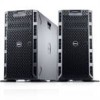Dell PowerEdge T620 Technical Guide - Page 34
RAID Setup with PERC H310 - fan noise
 |
View all Dell PowerEdge T620 manuals
Add to My Manuals
Save this manual to your list of manuals |
Page 34 highlights
management adjusts cooling according to what the system really needs, and draws lower fan power draw and generates lower acoustical noise levels than servers without such controls. Environmental specifications: The optimized thermal management makes the T620 reliable under a wide range of operating environments. Many configurations are compliant in expanded operating temperature environments, but a few are not. For environmental specifications and for configuration limitations on expanded operating temperature environments, see Table 30 in Appendix A. The acoustical design of the PowerEdge T620 reflects the following: Quiet library acoustics: The PowerEdge T620 is quiet enough for a library when minimally configured or quiet enough for an office setting in a typical configuration. Adherence to Dell's high sound quality standards: Sound quality is different from sound power level and sound pressure level in that it describes how humans respond to annoyances in sound, like whistles, hums, and so on. One of the sound quality metrics in the Dell specification is prominence ratio of a tone, which is listed in Table 21. Configurable for low acoustics: The following are configuration considerations you should make if acoustics is important to you: - Storage devices: - Because hard drive noise scales with spindle speed, the quietest option for rotational storage media is a 7200-rpm SATA drive. The loudest option is a 15k SAS drive. - Solid-state drives are even quieter than rotational drives because they have no sound associated with spinning. - Noise levels increase with the quantity of hard drives; using fewer hard drives will have a lower acoustical output. - PCIe SSD cards, such as Fusion-io, require more airflow for cooling, resulting in significantly higher noise levels. - Redundant fans: Fan noise from the non-redundant, two-fan system is lower than that of the redundant, six-fan system. - Impacts of cards: > Quantity of PCIe cards: When more than two PCIe cards are installed, the system fan speed/noise level will be higher. > Types of PCIe cards: The fan speed/noise level will be higher if a GPU and PERC H710 is installed. - System Profile settings in BIOS and Thermal settings in iDRAC7 BIOS settings: Performance Per Watt (DAPC or OS) may be quieter than Performance or Dense Configuration (iDRAC Settings > Thermal > Max. Exhaust Temperature or Fan speed offset). - Hot spare feature of power supply unit: In system default setting, the hot spare feature is disabled; acoustical output from the power supplies is lowest in this setting. - RAID Setup with PERC H310: A system configured as non-RAID will have a higher noise level than a system configured as RAID. Noise ramp and descent during bootup from power off: Fan speed noise levels ramp during the boot process (from power off to power on) to add a layer of protection for component cooling in case the system does not boot properly. To keep the bootup process as quiet as possible, the fan speed reached during bootup is limited to about half of full speed.















